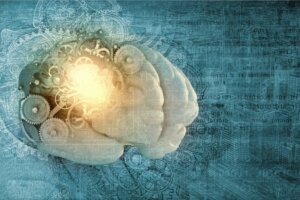What's Metamemory?

What’s metamemory? Does this concept sound familiar to you? Memory is a cognitive skill that allows us to have identity, learn, store memories, and consolidate or reinforce the imprint of what we’ve already learned.
Knowing in detail how memory works can help us retain information better, as well as optimize this skill. This is precisely what metamemory is about: the knowledge of one’s own memory.
But what else does metamemory encompass? What’s its relationship to mnemonic rules? How do people study this phenomenon? How can we enhance it? We’ll answer all of these questions and more in a brief guide to this very interesting skill that allows us to be who we are.
“We’re all the pieces of what we remember.”
-Cassandra Clare-

What’s metamemory?
Metamemory is the knowledge we have of our own memory. More specifically, and according to a study by González (1997) titled “Metamemory and learning of texts”, metamemory is defined as “The knowledge and control that a person has over the functioning of their memory”.
This also includes the knowledge of the different phases of the memory, which are:
- Codification.
- Storage.
- Retrieval.
The more metamemory we have, the more we understand about memory. As a result, we’ll know more about how to enhance it and its limitations. Thus, metamemory doesn’t only include the knowledge of memory but also its control and mastery.
Memory and metamemory
As we see, metamemory encompasses the knowledge of one’s own memory, in the same way that metalanguage constitutes the knowledge of one’s own language, to name but two examples. To enhance memory (or to get the most out of it), we often resort to so-called mnemonic rule strategies.
According to a study conducted by Campos & Ameijide (2014), mnemonic strategies don’t only influence and benefit memory but also metamemory. However, it all depends on the type of strategies used.
How to promote metamemory
Metamemory, like memory, can be enhanced. In what way? Firstly, by learning everything we need to know about how memory works. This includes knowing how the brain operates at each stage of the memory process.
We need to understand what happens when we encode a memory, when we store and retrieve it, the changes that occur in the brain, and how our emotions influence it. The relationship between emotions and memory has been widely demonstrated.
All this can be learned, no more and no less, than by reading and studying. In order to do this, we can easily lay our hands on many interesting books on human memory.
On the other hand, these mnemonic rules we’ve already mentioned can help us to enhance this cognitive process. In this sense, the more we work on it, the more we’ll know about it. Thus, these kinds of strategies can also improve metamemory.

The study of metamemory
In their book Metamemory: A Theoretical Framework and New Findings, Nelson and Narens (1990), propose that the study of metamemory should be conducted in three main stages. These are:
- Acquisition (before learning itself).
- Retention (maintaining previously-acquired knowledge).
- A conscious and self-directed retrieval of information.
On the other hand, and in relation to the study of metamemory, people can make judgments regarding their own memory, or, rather, of the process that implies memorization.
These metamnemonic judgments, according to the authors, can be conducted in four different stages of the learning process.
Let’s imagine that we’re dealing with a memorization task in order to understand these stages:
- Before the acquisition process. At this point, the items haven’t yet been learned. At this stage, the person has to predict how easy or difficult it’ll be to learn the task in question (ease of learning judgments).
- During or immediately after the acquisition. In other words, right after acquiring the memory but before the recall test. Here, the person estimates the level of knowledge they possess (judgments of learning).
- During the test. During the test, the person evaluates the memory that they expect to obtain when tested on the matter. This test could be in the same format or of a different nature. This is what we call the “sensation” or “feeling” of knowing.
- After the memory. Finally, we reach the stage that comes after employing their memory. Here, the person has to manifest the degree of confidence they have with each of their given answers (judgment of confidence).
Conclusions
Thus, as we can see, metamemory goes a little beyond the mere knowledge of memory. If we delve a little deeper, we find that it also includes the knowledge of all its functions and stages. We can also say that of mnemonic strategies, which can be useful to us.
This way, we can see how knowing and understanding about memory (metamemory) also implies knowing its strengths (how to take advantage of it) and its limitations.
“Remembering is easy for anyone who has memory, forgetting is difficult for those who have a heart.”
-Gabriel García Márquez-
What’s metamemory? Does this concept sound familiar to you? Memory is a cognitive skill that allows us to have identity, learn, store memories, and consolidate or reinforce the imprint of what we’ve already learned.
Knowing in detail how memory works can help us retain information better, as well as optimize this skill. This is precisely what metamemory is about: the knowledge of one’s own memory.
But what else does metamemory encompass? What’s its relationship to mnemonic rules? How do people study this phenomenon? How can we enhance it? We’ll answer all of these questions and more in a brief guide to this very interesting skill that allows us to be who we are.
“We’re all the pieces of what we remember.”
-Cassandra Clare-

What’s metamemory?
Metamemory is the knowledge we have of our own memory. More specifically, and according to a study by González (1997) titled “Metamemory and learning of texts”, metamemory is defined as “The knowledge and control that a person has over the functioning of their memory”.
This also includes the knowledge of the different phases of the memory, which are:
- Codification.
- Storage.
- Retrieval.
The more metamemory we have, the more we understand about memory. As a result, we’ll know more about how to enhance it and its limitations. Thus, metamemory doesn’t only include the knowledge of memory but also its control and mastery.
Memory and metamemory
As we see, metamemory encompasses the knowledge of one’s own memory, in the same way that metalanguage constitutes the knowledge of one’s own language, to name but two examples. To enhance memory (or to get the most out of it), we often resort to so-called mnemonic rule strategies.
According to a study conducted by Campos & Ameijide (2014), mnemonic strategies don’t only influence and benefit memory but also metamemory. However, it all depends on the type of strategies used.
How to promote metamemory
Metamemory, like memory, can be enhanced. In what way? Firstly, by learning everything we need to know about how memory works. This includes knowing how the brain operates at each stage of the memory process.
We need to understand what happens when we encode a memory, when we store and retrieve it, the changes that occur in the brain, and how our emotions influence it. The relationship between emotions and memory has been widely demonstrated.
All this can be learned, no more and no less, than by reading and studying. In order to do this, we can easily lay our hands on many interesting books on human memory.
On the other hand, these mnemonic rules we’ve already mentioned can help us to enhance this cognitive process. In this sense, the more we work on it, the more we’ll know about it. Thus, these kinds of strategies can also improve metamemory.

The study of metamemory
In their book Metamemory: A Theoretical Framework and New Findings, Nelson and Narens (1990), propose that the study of metamemory should be conducted in three main stages. These are:
- Acquisition (before learning itself).
- Retention (maintaining previously-acquired knowledge).
- A conscious and self-directed retrieval of information.
On the other hand, and in relation to the study of metamemory, people can make judgments regarding their own memory, or, rather, of the process that implies memorization.
These metamnemonic judgments, according to the authors, can be conducted in four different stages of the learning process.
Let’s imagine that we’re dealing with a memorization task in order to understand these stages:
- Before the acquisition process. At this point, the items haven’t yet been learned. At this stage, the person has to predict how easy or difficult it’ll be to learn the task in question (ease of learning judgments).
- During or immediately after the acquisition. In other words, right after acquiring the memory but before the recall test. Here, the person estimates the level of knowledge they possess (judgments of learning).
- During the test. During the test, the person evaluates the memory that they expect to obtain when tested on the matter. This test could be in the same format or of a different nature. This is what we call the “sensation” or “feeling” of knowing.
- After the memory. Finally, we reach the stage that comes after employing their memory. Here, the person has to manifest the degree of confidence they have with each of their given answers (judgment of confidence).
Conclusions
Thus, as we can see, metamemory goes a little beyond the mere knowledge of memory. If we delve a little deeper, we find that it also includes the knowledge of all its functions and stages. We can also say that of mnemonic strategies, which can be useful to us.
This way, we can see how knowing and understanding about memory (metamemory) also implies knowing its strengths (how to take advantage of it) and its limitations.
“Remembering is easy for anyone who has memory, forgetting is difficult for those who have a heart.”
-Gabriel García Márquez-
All cited sources were thoroughly reviewed by our team to ensure their quality, reliability, currency, and validity. The bibliography of this article was considered reliable and of academic or scientific accuracy.
- Barcroft, J. Chapelle, A. (Ed.). (2012). The Encyclopedia of Applied Linguistics. p.3. Hoboken, Oxford, UK: Wiley-Blackwell
- Campos, A., & Ameijide, L. (2014). Mnemotecnia de la palabra clave con dibujos y juicios metamnemónicos de personas mayores. Revista Iberoamericana de Psicología y Salud, 5(1), 23-38.
- Flavell, J.H., Wellman, H.M. (1975). Metamemory. Minnesota University, Minneapolis.
- González, A. (1997). Metamemoria y aprendizaje de textos. Estudios de Psicología, 58, 59-83.
- Ruiz, M. (2008). Las caras de la memoria. Madrid: Pearson Educación S. A.
This text is provided for informational purposes only and does not replace consultation with a professional. If in doubt, consult your specialist.







